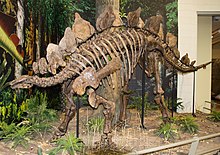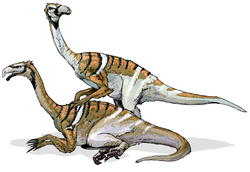Portal:Dinosaurs
IntroductionDinosaurs are a diverse group of reptiles of the clade Dinosauria. They first appeared during the Triassic period, between 243 and 233.23 million years ago (mya), although the exact origin and timing of the evolution of dinosaurs is a subject of active research. They became the dominant terrestrial vertebrates after the Triassic–Jurassic extinction event 201.3 mya and their dominance continued throughout the Jurassic and Cretaceous periods. The fossil record shows that birds are feathered dinosaurs, having evolved from earlier theropods during the Late Jurassic epoch, and are the only dinosaur lineage known to have survived the Cretaceous–Paleogene extinction event approximately 66 mya. Dinosaurs can therefore be divided into avian dinosaurs—birds—and the extinct non-avian dinosaurs, which are all dinosaurs other than birds. Dinosaurs are varied from taxonomic, morphological and ecological standpoints. Birds, at over 11,000 living species, are among the most diverse groups of vertebrates. Using fossil evidence, paleontologists have identified over 900 distinct genera and more than 1,000 different species of non-avian dinosaurs. Dinosaurs are represented on every continent by both extant species (birds) and fossil remains. Through the first half of the 20th century, before birds were recognized as dinosaurs, most of the scientific community believed dinosaurs to have been sluggish and cold-blooded. Most research conducted since the 1970s, however, has indicated that dinosaurs were active animals with elevated metabolisms and numerous adaptations for social interaction. Some were herbivorous, others carnivorous. Evidence suggests that all dinosaurs were egg-laying, and that nest-building was a trait shared by many dinosaurs, both avian and non-avian. (Full article...) Selected articleStyracosaurus was a genus of herbivorous ceratopsian dinosaur from the Cretaceous Period (Campanian stage), about 76.5 to 75.0 million years ago. It had four to six long horns extending from its neck frill, a smaller horn on each of its cheeks, and a single horn protruding from its nose, which may have reached dimensions of around 60 centimeters (2 ft) long and 15 centimeters (6 in) wide. The function or functions of the horns and frills have been the subject of debate for many years. Styracosaurus was a large dinosaur, reaching lengths of 5.5 meters (18 ft) and weighing nearly 3 tons. It stood about 1.8 meters (6 ft) tall. Styracosaurus possessed four short legs and a bulky body. Its tail was rather short. It also had a beak and flat cheek teeth, indicating that its diet was herbivorous. Like other ceratopsians, this dinosaur may have been a herd animal, traveling in large groups, as suggested by bonebeds. Named by Lawrence Lambe in 1913, Styracosaurus is a member of the Centrosaurinae. Two species, S. albertensis and S. ovatus are currently assigned to Styracosaurus. Other species assigned to the genus have since been reassigned elsewhere. (see more...) TopicsSubcategoriesSelected image
Photo credit: User:LadyofHats Did you know...
Things you can do
Featured article candidates
Peer reviews
Articles to be merged
Articles to be split
Related content
Associated WikimediaThe following Wikimedia Foundation sister projects provide more on this subject:
Discover Wikipedia using portals |





























